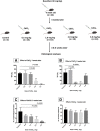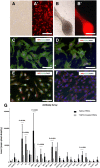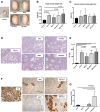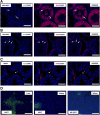Co-transplantation of mesenchymal stem cells improves spermatogonial stem cell transplantation efficiency in mice
- PMID: 30463610
- PMCID: PMC6249754
- DOI: 10.1186/s13287-018-1065-0
Co-transplantation of mesenchymal stem cells improves spermatogonial stem cell transplantation efficiency in mice
Abstract
Background: Spermatogonial stem cell transplantation (SSCT) could become a fertility restoration tool for childhood cancer survivors. However, since in mice, the colonization efficiency of transplanted spermatogonial stem cells (SSCs) is only 12%, the efficiency of the procedure needs to be improved before clinical implementation is possible. Co-transplantation of mesenchymal stem cells (MSCs) might increase colonization efficiency of SSCs by restoring the SSC niche after gonadotoxic treatment.
Methods: A mouse model for long-term infertility was developed and used to transplant SSCs (SSCT, n = 10), MSCs (MSCT, n = 10), a combination of SSCs and MSCs (MS-SSCT, n = 10), or a combination of SSCs and TGFß1-treated MSCs (MSi-SSCT, n = 10).
Results: The best model for transplantation was obtained after intraperitoneal injection of busulfan (40 mg/kg body weight) at 4 weeks followed by CdCl2 (2 mg/kg body weight) at 8 weeks of age and transplantation at 11 weeks of age. Three months after transplantation, spermatogenesis resumed with a significantly better tubular fertility index (TFI) in all transplanted groups compared to non-transplanted controls (P < 0.001). TFI after MSi-SSCT (83.3 ± 19.5%) was significantly higher compared to MS-SSCT (71.5 ± 21.7%, P = 0.036) but did not differ statistically compared to SSCT (78.2 ± 12.5%). In contrast, TFI after MSCT (50.2 ± 22.5%) was significantly lower compared to SSCT (P < 0.001). Interestingly, donor-derived TFI was found to be significantly improved after MSi-SSCT (18.8 ± 8.0%) compared to SSCT (1.9 ± 1.1%; P < 0.001), MSCT (0.0 ± 0.0%; P < 0.001), and MS-SSCT (3.4 ± 1.9%; P < 0.001). While analyses showed that both native and TGFß1-treated MSCs maintained characteristics of MSCs, the latter showed less migratory characteristics and was not detected in other organs.
Conclusion: Co-transplanting SSCs and TGFß1-treated MSCs significantly improves the recovery of endogenous SSCs and increases the homing efficiency of transplanted SSCs. This procedure could become an efficient method to treat infertility in a clinical setup, once the safety of the technique has been proven.
Keywords: Fertility restoration; Infertility; Mesenchymal stem cells; Spermatogonial stem cells; Transplantation.
Conflict of interest statement
Ethics approval and consent to participate
All procedures performed on the animals were in accordance with the ethical standards of the Federation for Laboratory Animal Science Associations guidelines and approved by the Institutional Animal Care and Use Committee of the Vrije Universiteit Brussel (VUB) Brussels, Belgium (14-216-2 and 16-216-3). Consent to participate is not applicable.
Consent for publication
Not applicable.
Competing interests
The authors declare that they have no competing interests.
Publisher’s Note
Springer Nature remains neutral with regard to jurisdictional claims in published maps and institutional affiliations.
Figures





Similar articles
-
Does co-transplantation of mesenchymal and spermatogonial stem cells improve reproductive efficiency and safety in mice?Stem Cell Res Ther. 2019 Oct 22;10(1):310. doi: 10.1186/s13287-019-1420-9. Stem Cell Res Ther. 2019. PMID: 31640769 Free PMC article.
-
Long-term health in recipients of transplanted in vitro propagated spermatogonial stem cells.Hum Reprod. 2018 Jan 1;33(1):81-90. doi: 10.1093/humrep/dex348. Hum Reprod. 2018. PMID: 29165614 Free PMC article.
-
Spermatogonial stem cell autotransplantation and germline genomic editing: a future cure for spermatogenic failure and prevention of transmission of genomic diseases.Hum Reprod Update. 2016 Sep;22(5):561-73. doi: 10.1093/humupd/dmw017. Epub 2016 May 30. Hum Reprod Update. 2016. PMID: 27240817 Free PMC article. Review.
-
Fertility of Male Germline Stem Cells Following Spermatogonial Transplantation in Infertile Mouse Models.Biol Reprod. 2016 May;94(5):112. doi: 10.1095/biolreprod.115.137869. Epub 2016 Apr 6. Biol Reprod. 2016. PMID: 27053363
-
Can mesenchymal stem cells improve spermatogonial stem cell transplantation efficiency?Andrology. 2017 Jan;5(1):2-9. doi: 10.1111/andr.12304. Andrology. 2017. PMID: 27989021 Review.
Cited by
-
Manipulation of spermatogonial stem cells in livestock species.J Anim Sci Biotechnol. 2019 Jun 12;10:46. doi: 10.1186/s40104-019-0355-4. eCollection 2019. J Anim Sci Biotechnol. 2019. PMID: 31205688 Free PMC article. Review.
-
Therapeutic potential of Sertoli cells in vivo: alleviation of acute inflammation and improvement of sperm quality.Stem Cell Res Ther. 2024 Sep 4;15(1):282. doi: 10.1186/s13287-024-03897-9. Stem Cell Res Ther. 2024. PMID: 39227878 Free PMC article.
-
Fertility Protection, A Novel Concept: Umbilical Cord Mesenchymal Stem Cell-Derived Exosomes Protect against Chemotherapy-Induced Testicular Cytotoxicity.Int J Mol Sci. 2023 Dec 20;25(1):60. doi: 10.3390/ijms25010060. Int J Mol Sci. 2023. PMID: 38203232 Free PMC article.
-
Sertoli Cell-Conditioned Medium Induces Differentiation of Bone Marrow-Derived Mesenchymal Stem Cells to Male Germ-Like Cells in Busulfan-Induced Azoospermic Mouse Model.Reprod Sci. 2024 Feb;31(2):375-392. doi: 10.1007/s43032-023-01332-7. Epub 2023 Sep 22. Reprod Sci. 2024. PMID: 37737972
-
Mesenchymal stromal/stem cells and their exosomes for restoration of spermatogenesis in non-obstructive azoospermia: a systemic review.Stem Cell Res Ther. 2021 Apr 6;12(1):229. doi: 10.1186/s13287-021-02295-9. Stem Cell Res Ther. 2021. PMID: 33823925 Free PMC article.
References
Publication types
MeSH terms
Substances
LinkOut - more resources
Full Text Sources
Medical

